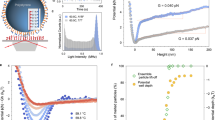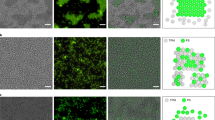Abstract
DNA is the premier material for directing nanoscale self-assembly, having been used to produce many complex forms1,2,3,4. Recently, DNA has been used to direct colloids5,6 and nanoparticles7,8 into novel crystalline structures, providing a potential route to fabricating meta-materials9 with unique optical properties. Although theory10,11,12 has sought the crystal phases that minimize total free energy, kinetic barriers13 remain essentially unstudied. Here we study interfacial equilibration in a DNA-directed microsphere self-assembly system5,6,14 and carry out corresponding detailed simulations. We introduce a single-nucleotide difference in the DNA strands on two mixed microsphere species, which generates a free-energy penalty5,15,16 for inserting ‘impurity’ spheres into a ‘host’ sphere crystal, resulting in a reproducible segregation coefficient. Comparison with simulation reveals that, under our experimental conditions, particles can equilibrate only with a few nearest neighbours before burial by the growth front, posing a potential impediment to the growth of complex structures.
This is a preview of subscription content, access via your institution
Access options
Subscribe to this journal
Receive 12 print issues and online access
$259.00 per year
only $21.58 per issue
Buy this article
- Purchase on Springer Link
- Instant access to full article PDF
Prices may be subject to local taxes which are calculated during checkout




Similar content being viewed by others
References
Winfree, E., Liu, F. R., Wenzler, L. A. & Seeman, N. C. Design and self-assembly of two-dimensional DNA crystals. Nature 394, 539–544 (1998).
Seeman, N. C. Biochemistry and structural DNA nanotechnology: An evolving symbiotic relationship. Biochemistry 42, 7259–7269 (2003).
Rothemund, P. W. K. et al. Design and characterization of programmable DNA nanotubes. J. Am. Chem. Soc. 126, 16344–16352 (2004).
Rothemund, P. W. K. Folding DNA to create nanoscale shapes and patterns. Nature 440, 297–302 (2006).
Biancaniello, P. L., Kim, A. J. & Crocker, J. C. Colloidal interactions and self-assembly using DNA hybridization. Phys. Rev. Lett. 94, 058302 (2005).
Kim, A. J., Biancaniello, P. L. & Crocker, J. C. Engineering DNA-mediated colloidal crystallization. Langmuir 22, 1991–2001 (2006).
Nykypanchuk, D., Maye, N. N., van der Lelie, D. & Gang, O. DNA-guided crystallization of colloidal nanoparticles. Nature 451, 549–552 (2008).
Park, S. Y. et al. DNA-programmable nanoparticle crystallization. Nature 451, 553–556 (2008).
Linden, S. et al. Magnetic response of metamaterials at 100 terahertz. Science 306, 1351–1353 (2004).
Tkachenko, A. V. Morphological diversity of DNA-colloidal self-assembly. Phys. Rev. Lett. 89, 148303 (2002).
Bozorgui, B. & Frenkel, D. Liquid–vapour transition driven by bond disorder. Phys. Rev. Lett. 101, 045701 (2008).
Largo, J., Starr, F. W. & Sciortino, F. Self-assembling DNA dendrimers: A numerical study. Langmuir 23, 5896–5905 (2007).
Lukatsky, D. B., Mulder, B. M. & Frenkel, D. Designing ordered DNA-linked nanoparticle assemblies. J. Phys. Condens. Matter 18, S567–S580 (2006).
Milam, V. T., Hiddessen, A. L., Crocker, J. C., Graves, D. J. & Hammer, D. A. DNA-driven assembly of bidisperse, micron-sized colloids. Langmuir 19, 10317–10323 (2003).
SantaLucia, J. A unified view of polymer, dumbbell, and oligonucleotide DNA nearest-neighbor thermodynamics. Proc. Natl Acad. Sci. USA 95, 1460–1465 (1998).
Peyret, N., Seneviratne, P. A., Allawi, H. T. & SantaLucia, J. Nearest-neighbor thermodynamics and NMR of DNA sequences with internal A·A, C·C, G·G, and T·T mismatches. Biochemistry 38, 3468–3477 (1999).
Biancaniello, P. L., Crocker, J. C., Hammer, D. A. & Milam, V. T. DNA-mediated phase behavior of microsphere suspensions. Langmuir 23, 2688–2693 (2007).
Kim, A. J., Manoharan, V. N. & Crocker, J. C. Swelling-based method for preparing stable, functionalized polymer colloids. J. Am. Chem. Soc. 127, 1592–1593 (2005).
Auer, S. & Frenkel, D. Numerical simulation of crystal nucleation in colloids. Advanced computer simulation approaches for soft matter. Sciences I 173, 149–208 (2005).
Mullins, W. W. & Sekerka, R. W. Morphological stability of a particle growing by diffusion or heat flow. J. Appl. Phys. 34, 323–329 (1963).
Mullins, W. W. & Sekerka, R. W. Stability of a planar interface during solidification of a dilute binary alloy. J. Appl. Phys. 35, 444–451 (1964).
Johnson, B. K. & Sekerka, R. F. Diffusion-limited aggregation: Connection to a free-boundary problem and lattice anisotropy. Phys. Rev. E 52, 6404 (1995).
Biancaniello, P. L. & Crocker, J. C. Line optical tweezers instrument for measuring nanoscale interactions and kinetics. Rev. Sci. Instrum. 77, 113702 (2006).
Beatty, K. M. & Jackson, K. A. Monte Carlo modeling of dopant segregation. J. Cryst. Growth 271, 495–512 (2004).
Acknowledgements
These studies were supported by the National Science Foundation under the DMR, NIRT and MRSEC programs. We thank A. Alsayed, Y. Han, V.N. Manoharan, V. T. Milam, M. Ung and M.-P. Valignat for discussions.
Author information
Authors and Affiliations
Contributions
The experiments were designed by A.J.K., P.L.B. and J.C.C., implemented by A.J.K., and analysed by A.J.K., T.S. and J.C.C. The simulations were designed by R.S. and T.S., implemented by R.S. and interpreted by R.S., J.C.C. and T.S. The interaction model was implemented by R.S. and P.L.B. J.C.C. and T.S. wrote the manuscript and oversaw the project.
Corresponding author
Supplementary information
Supplementary Information
Supplementary Information (PDF 1279 kb)
Rights and permissions
About this article
Cite this article
Kim, A., Scarlett, R., Biancaniello, P. et al. Probing interfacial equilibration in microsphere crystals formed by DNA-directed assembly. Nature Mater 8, 52–55 (2009). https://doi.org/10.1038/nmat2338
Received:
Accepted:
Published:
Issue Date:
DOI: https://doi.org/10.1038/nmat2338
This article is cited by
-
Crystal engineering with DNA
Nature Reviews Materials (2019)
-
Calculation of π and Classification of Self-avoiding Lattices via DNA Configuration
Scientific Reports (2019)
-
DNA-Coated Microspheres and Their Colloidal Superstructures
Macromolecular Research (2018)
-
Colloidal crystals with diamond symmetry at optical lengthscales
Nature Communications (2017)
-
A recipe for growth
Nature Materials (2017)



